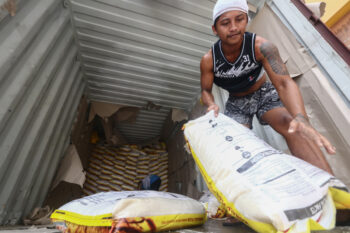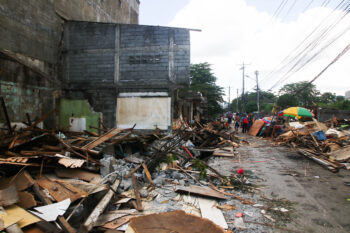DAVAO CITY (19 April 2011) — Since I was young, I have often heard my grandparents talk about their hometowns in Panay Island, Western Visayas.
Even my uncles also talk about their vacation experience in Iloilo, particularly Pototan town, which is about 45 minutes away from Iloilo City.
Just last week, Ruby and I had the chance to visit Panay Island, where most of the settlers in Southwestern Mindanao came from. Having born and grown up in Mindanao, I have always been eager to visit our beloved Iloilo.
There’s a joke among Ilonggos that when you say you’re going to visit Iloilo, you will have to “renew.” It means you have to have your “license to boast” renewed in Iloilo.
It has been a joke that Ilonggos are known “tikalon” or boastful. Tikalon also means talking exaggeratedly. I still wonder why.
There is a joke that says: “Didto sa Iloilo, ang kwarta gina-pala kag gina-piko (In Iloilo, money is shovelled and hoed).” This is the most popular joke that some strangers would tease the Ilonggos about.
When we arrived in Iloilo, I didn’t see people “ga-piko, ga-pala sang kwarta.” But I still find it amusing how some Ilonggos in Iloilo speak or describe something.
Most Ilonggos in Iloilo speak or describe something with hyperbolic terms and exaggerated body expressions. If you’re a stranger, you would really find it comical and even doubt if they are precisely expressing their thoughts.
Some Ilonggos in North Cotabato do not speak the way the Ilonggos in Iloilo do except for those who are in Aleosan, Arakan, M’lang, Matalam and Tulunan. These towns are the known bailiwicks of Ilonggos.
The tone of Ilonggos in North Cotabato is different from those in Iloilo province. Pure Ilonggos speak with a “waving accent” while some Ilonggos in North Cotabato speak the dialect with a “hard accent.”
Some Ilonggos in Mindanao have a joke that in Iloilo, Coke is much longer than in Mindanao because there they say: “Ayooo, mabakaaal koo Cooooooke.” Most Ilonggos in Iloilo speak softly even if they are mad.
“Baw, ti ga balud-balud gid ila hinambalan sa Iloilo,” is how they would describe it.
There were a few words also that amused me when we went around the city. On board a jeep, a passenger told the driver: “Nong sa babaw lang.” It’s my first time to hear “babaw” when telling the driver that you are getting off.
Since it’s my first time to hear the word, I looked outside to see if there’s an overpass or a skyway ahead because for me “babaw” means “top.”
In Cebuano-dominated areas, we say “sa unahan lang” or “lugar lang.” Although when you say “lugar lang,” the drivers in Iloilo would understand it.
In North Cotabato areas, we say “sa unhan lang.”
When we were in Calinog town, about an hour bus-ride north of Iloilo, we asked a vendor how much each bibingka cost. She said “tag-lima,” which means P5 each. But here in Mindanao, we say “singko.” They say “pulo” instead of “dyes” (P10).
In other parts of Iloilo, they also count in the same way.
In Passi City, after disembarking from the bus, we asked the sikad drivers how far the church is.
One of the drivers said: “Marayo pa, sakay lang kamo.” “Marayo” means malayo (far). But after a few meters as we turned around the corner, we already saw the church. Baw, ti marayo gid to para sa ila.
In some parts of Iloilo, some words with “l” are replaced with “r.” This is known as Karay-a dialect. Karay-a dialect is most common among people from Antique province of Panay Island.
Hardcore Karay-a is hard to understand. In Bisaya, we say ugma while it’s buwas in Ilonggo. But in Karay-a, it’s “rum-an.”
I’ve been hearing Karay-a since I was a kid especially if we are in Midsayap with our relatives who are often in Iloilo. They say “bu-ol” or “bul-a” when they tell you to get something. It means “kuhaa” or “get it.”
Other Ilonggo terms also means differently in Cebuano. One time when we were watching a certain game on TV, Ruby said: ”nagkumpol lagi na sila?” I told her: “Paano nakumpol nga ga-dula pa gani sila?”
In Cebuano kumpol means “gather” while in Ilonggo it literally means a person with only one arm.
When we say “karon” in Ilonggo, it means later. While in Cebuano it means right now.
So many terms that I would find amusing when spoken by Cebuano-speaking people and mean the opposite in Ilonggo dialect. But I still find even more amusing to hear my fellow Ilonggo describe or say something with corresponding sound effects and body gestures.
Indi man tikalon ang Ilonggo ah, abi nyo lang na. Nasobrahan lang gid anda nga body gestures kag ga balud-balud.
***
While in Molo district, I asked a traffic officer in blue uniform. So let’s call him Blue Boy:
Kitoy: Ser, diin dire may ga serve sang pancit Molo?
Blue Boy: Ang tawag kaja nga lugar, Molo. Pero daw waay man ga luto kaja sang Molo. Lugar man ning Molo dire Iloilo.
Kitoy: Ti, sige sir ah. Pa Miag-ao na lang kami anay.
Blue Boy: Dira sa babaw, may karinderia jan.Ti basi may pancit jan, pero pancit molo, daw waay gid tana na dire.
(Keith Bacongco is a Mindanews reporter/photographer and is a proud Full Blooded Ilonggo (FBI) married to a Davaoeña in Davao City.)







